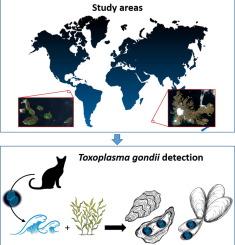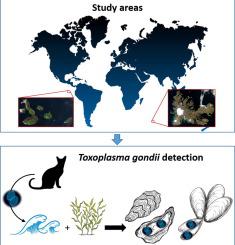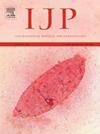在凯尔盖朗群岛和加拉帕戈斯群岛的野生双壳贝中检测到弓形虫:与猫群的距离、暴露于海流和海藻密度的影响
IF 3.7
2区 医学
Q1 PARASITOLOGY
引用次数: 0
摘要
原生动物弓形虫的卵囊存在于猫科动物的粪便中,会被冲入沿岸水域,并在那里存留数月,附着在藻类上,并在无脊椎动物体内积累。我们利用野生双壳贝类来评估这种人畜共患病寄生虫对凯尔盖朗群岛和加拉帕戈斯群岛沿岸水域的污染情况。此外,我们还利用这两个群岛截然不同的情况,确定了一些潜在的污染驱动因素。在加拉帕戈斯群岛,猫的密度达到每平方公里 142 只,通过实时定量 PCR(qPCR)检测,15.38% 的采样牡蛎(Saccostrea palmula)的淋病双球菌检测呈阳性(n = 260),在所有八个采样点都发现了阳性样本。在凯尔盖朗(Kerguelen),每平方公里有 1-3 只猫,在 120 个检测的贻贝(Mytilus edulis platensis)中,有 40.83% 呈阳性,在五个采样点中的四个采样点都发现了阳性样本。这些发现提供了这些群岛沿海水域受到淋病双球菌污染的证据。此外,在距离最近的猫群 20 千米(加拉帕戈斯群岛)和 5 千米(凯尔盖朗岛)以外的岛屿上也发现了 T. gondii 阳性双壳贝,这表明 T. gondii 卵囊可以通过水传播机制从最初的沉积地点扩散到几千米以外的地方。在加拉帕戈斯群岛,径流并不频繁,而且所有地点都暴露在水流中,qPCR 阳性双壳贝的流行率在不同地点之间并无显著差异(p = 0.107)。在凯尔盖朗岛,由于径流频繁,各地点的水流情况各不相同,因此双壳类动物的发病率差异很大(p = 0.001)。在凯尔盖朗贻贝中检测到的淋病双球菌与现场暴露于水流的情况(几率比(OR)60.2,p <0.001)和现场巨型海藻林的密度(OR 2.624,p <0.001)有明显的相关性。这表明,双壳类动物不仅会受到由水流传播的卵囊的污染,也会因食用海藻林中往往会形成的含有卵囊的海洋聚集体而受到污染。本文章由计算机程序翻译,如有差异,请以英文原文为准。


Detection of Toxoplasma gondii in wild bivalves from the Kerguelen and Galapagos archipelagos: influence of proximity to cat populations, exposure to marine currents and kelp density
Oocysts of the protozoan Toxoplasma gondii are found in felid feces and can be washed into coastal waters, where they persist for months, attaching to algae and accumulating in invertebrates. We used wild bivalves to assess contamination of coastal waters of the Kerguelen and Galapagos archipelagos by this zoonotic parasite. Additionally, we leveraged the contrasting situations of these archipelagos to identify some potential drivers of contamination. In the Galapagos, with a cat density reaching 142 per km2, 15.38% of the sampled oysters (Saccostrea palmula) tested positive for T. gondii by quantitative real-time PCR (qPCR) (n = 260), and positive samples were found in all eight sampling sites. In Kerguelen, with 1-3 cats per km2, 40.83% of 120 tested mussels (Mytilus edulis platensis) were positive, and positive samples were found in four out of the five sampling sites. These findings provide evidence of T. gondii contamination in the coastal waters of these archipelagos. Furthermore, T. gondii-positive bivalves were found on islands located 20 km away (Galapagos) and 5 km away (Kerguelen) from the nearest cat population, indicating that T. gondii oocysts can disperse through waterborne mechanisms over several kilometers from their initial deposition site. In the Galapagos, where runoff is infrequent and all sites are exposed to currents, the prevalence of qPCR-positive bivalves did not show significant variations between sites (p = 0.107). In Kerguelen where runoff is frequent and site exposure variable, the prevalence varied significantly (p < 0.001). The detection of T. gondii in Kerguelen mussels was significantly correlated with the site exposure to currents (odds ratio (OR) 60.2, p < 0.001) and the on-site density of giant kelp forests (OR 2.624, p < 0.001). This suggests that bivalves can be contaminated not only by oocysts transported by currents but also by consuming marine aggregates containing oocysts that tend to form in kelp forests.
求助全文
通过发布文献求助,成功后即可免费获取论文全文。
去求助
来源期刊
CiteScore
8.40
自引率
2.50%
发文量
76
审稿时长
23 days
期刊介绍:
International Journal for Parasitology offers authors the option to sponsor nonsubscriber access to their articles on Elsevier electronic publishing platforms. For more information please view our Sponsored Articles page. The International Journal for Parasitology publishes the results of original research in all aspects of basic and applied parasitology, including all the fields covered by its Specialist Editors, and ranging from parasites and host-parasite relationships of intrinsic biological interest to those of social and economic importance in human and veterinary medicine and agriculture.

 求助内容:
求助内容: 应助结果提醒方式:
应助结果提醒方式:


